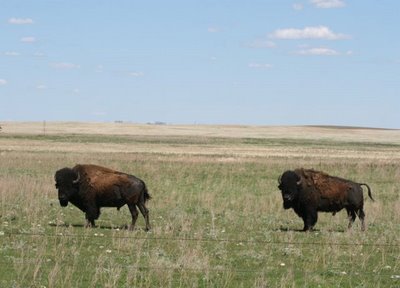
Drive across North Dakota on Highway 200, and you’ll see bison, on billboards, restaurants, and green road signs. My favorite heralds two little towns, named Buffalo and Alice. The words are stacked, reading Buffalo Alice, conjuring up a wooly-haired, gun-slinging, fringe-bedecked cowgirl.
Bison no longer flow like a black river of boulders over buttes and plains. But they are still out there, in scattered herds on private and public land. I spent two mornings with Oren Krapp, who runs 400 head of bison on a 2500 acre piece of virgin prairie outside Pingree, North Dakota. Gray-green grasses, silverbush and buckbrush, buffalo bean and buffalo grass wave in the warm wind as we roll slowly along in a wagon over Oren’s land. This land has never known a plow, and the native prairie plants are diverse and lush.
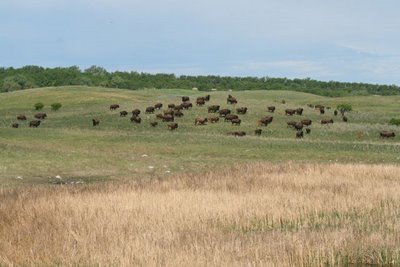
Oren Krapp kept cattle all his life until he got bison. At first he treated them like cattle, rounding them up a couple of times a year to tag and inoculate them. When it came time for slaughter, he’d round them up and truck them to a stockyard to fatten them on corn, trying for a USDA prime rating for the meat. But bison won’t eat more than they need, and they don’t fatten easily. And the handling and capture stressed them so badly that their meat didn’t taste good. So Oren simply stopped doing that. In fact, he stopped doing much at all. He doesn’t round them up anymore, and he doesn’t give them shots or treat them for illnesses, because they never get sick. Cancer, so common in beef cattle, is unknown in bison.
I asked Oren how bison compared to cattle. “In intelligence, the bison is to a beef cow like you are to that rock on the road there.” Bison know what forage to eat and what time of year it’s most nutritious. They’ll switch around so no one plant ever takes over their pasture. In winter, they paw to uncover their food, and in a dry summer they can smell water three miles away, and find it. When the snow piles up and tops Oren’s perimeter fence, his bison go wandering over neighboring land, stopping at the highway. “Nobody minds,” Oren told me. “They don’t hurt anything.” And then they come home, because this oasis of unbroken prairie has everything they need, and they know where they belong.
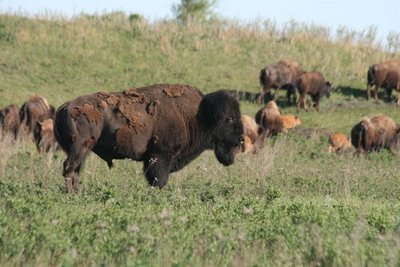 Early on, Oren followed instructions to fence off portions of his range, and permit the bison to graze on only parts of it at one time. "I spent all my time mending fence, until I realized that the bison weren't going for it. Fences don't mean anything to them. Now I let them go wherever they want."
Early on, Oren followed instructions to fence off portions of his range, and permit the bison to graze on only parts of it at one time. "I spent all my time mending fence, until I realized that the bison weren't going for it. Fences don't mean anything to them. Now I let them go wherever they want."Last year, after an April storm dumped four feet of snow, killing 40% of his neighbor’s cattle, Oren went out to check on his bison. One bison cow was down and wouldn’t get up. He thought he’d found his first winter-killed animal. As he pressed closer, she got to her feet, revealing a tiny orange calf, which had been covered by a blanket of the softest wool on its mother’s neck. Mother and baby were fine. A bison cow won’t have her first calf until she’s five or six years old, but she’ll continue calving into her mid-twenties—twice the reproductive lifespan of beef.
We watched a group of cow bison, each one accompanied by a wooly orange calf, dewy-eyed and short-coupled. “A bison will never leave her calf the way a beef will,” he commented. “We’ve got all kinds of coyotes around here, but I don’t worry about them around bison. The coyotes know that if they tried anything with a calf, the herd would be all over them.”
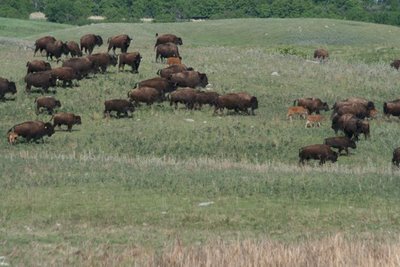
Oren pointed to a distant herd of Herefords, grazing planted fescue on the plowed field just over his fence. “In a hard winter, my neighbor might lose 40% of his cattle, even when he takes them in and feeds them. I leave the bison herd out all winter and don’t lose a one.”
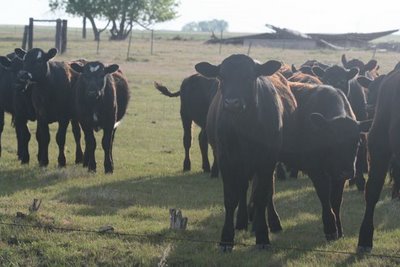
When Oren wishes to cull or harvest an animal, it’s dropped where it stands with a single shot, into the prairie grass where it grew up. No roundup, no trucking, no capture and confinement, no slaughterhouse trauma. There’s an elegance to his operation, a respect for the animal’s natural history and native intelligence, that has been utterly lost in the close-cropped pastures, muddy feedlots, and dark slaughterhouses that define the short lives of beef cattle. We stood on a promontory, facing into the warm wind. On the ancient seabed that stretched below, bison flowed in a black-brown river around a slough, over hill and hummock, disappearing into the distance.
In central North Dakota, a place most of us would call the middle of nowhere, there is a somewhere that retains its ancient vitality. There is an intricate cluster of animals and plants, soil, sky and people, that are as they always were, that are as they should be, that spins in an eddy of time, perfect and endlessly renewed.
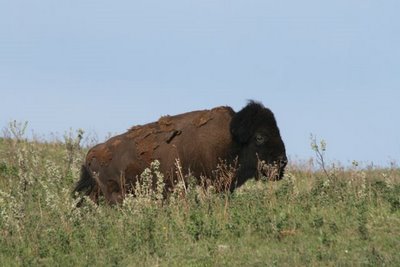






14 comments:
When I finished reading I sighed a deep sigh and realized I'd been holding my breath.
That was beautifully written.
I hope I get to see the prairie of North Dakota.
I was born in Montana and I wonder if there is a sense of place that I'm not aware of -- that open prairie looks so appealing. Wow, bison are wonderful creatures.
Thank you for this wonderfully refreshing story. What marvelous animals and what a marvelous man. How lucky you were to meet him.
Sounds like an NPR spot to me!
Beautifully written. I enjoy your posts very much.
Thanks, NCMTWMN: One of my many frustrations: my NPR editor loved the piece, but said it cried out for sound effects and an audio interview with Oren. Yeah, I know. The journalist in me arm-wrestles the commentator more and more. Sigh. I guess one of these days I'll have to invest in a pocket recorder and get savvy with recording and editing.
Julie - I remember Buffalo Alice from many trips heading east to MN from MT! I had the same vision of the female form of Buffalo Bill.
I have a soft spot for bison, having grown up with at least 8 in a pasture next door. I wish more ranchers throughout the west would realize the potential of raising bison too.
Liza lee - Some of the largest expanses of remaining prairie in NA is in Eastern Montana! A group called the American Prairie Foundation is working to secure a large private reserve with free ranging bison there as well.
I loved this post. I agree with Lynne--although I wasn't holding my breath.
It is beautifully written.
I heard a story on Sunday morning on CBS about native Americans who are returning the land to prairie--growing prairie grasses and other plants, and bringing buffalo into the scene.
There is such beauty in the way things are meant to be.
Your words honor a lovely land.
Nice to know there is a man who senses and preserves the spirit of the wide open prairie.
What a great lesson Julie. I never knew all that about bison. Such huge, yet sensitive animals. :c)
"On the ancient seabed that stretched below, bison flowed in a black-brown river...."
A beautiful story, and that sentence above all took my breath away.
I saw the same things,wx but you brought it to life.
You should think about taking up writing.
Wow. Fantastic post - the writing is wonderful as is the subject. We were lucky enough to spend a few days in North Dakota on a cross country trip with our 2 boys 5 years ago and it truly was gorgeous. There is a bison farm on our road in NH; it's transporting to drive a winding forest road and suddenly come across an open vista with bison grazing in the background. Thanks for the reminder!
Your stunning writing does capture that sense of place so perfectly. We have the Tallgrass Prairie Preserve here where the Nature Conservancy has reintroduced bison as a critical part of the prairie ecosystem restoration. The 2500 bison are not supplemented with anything but natural prairie grasses. To journey there is to understand that the word ocean can have another meaning; the undulating sea of grass is an unforgettable moment to behold. Be careful Liza, that sweeping prairie will call you back home. It certainly did me.
p.s. - a buffalo burger holds its own any day against a beef burger. Absolutely delicious and much more nutritious.
Wow, what an awesome story Julie. It's especially poignant when you think back to the pioneer days and remember all the buffalo that were killed (many just for sport). Thank God for people like Oren who are once again allowing them to live as buffalo should.
P.S. And did you know their fleece can also be spun into wonderfully soft yarn? Watch your mailbox in a few days for a birthday gift from Nature Knitter!
Post a Comment